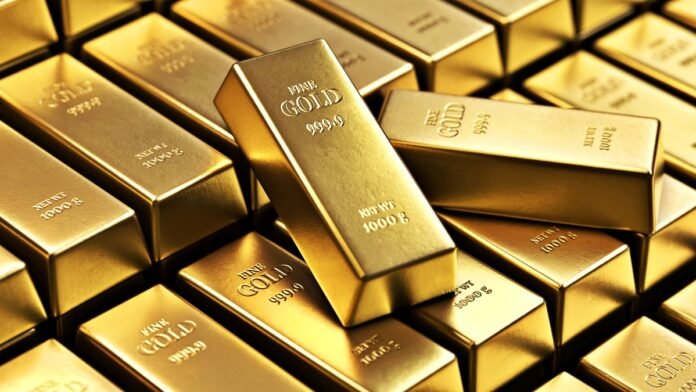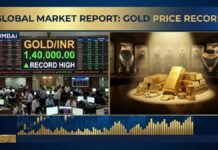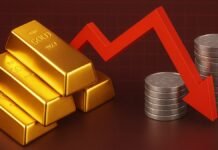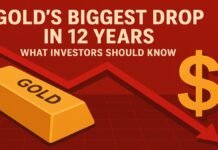
Key Points
- Gold futures reached an all-time high of $4,392 per ounce on October 17, 2025, currently trading at $4,360.90, marking the biggest weekly gain since 2008 with an 8.7% surge
- The unprecedented rally from $3,500 to $4,000 occurred in just 36 days, compared to the historical average of 1,036 days for a $500 increase
- Gold has climbed an extraordinary 65% year-to-date in 2025, the largest annual increase in 45 years
- Silver outperformed gold with prices surging past $53 per ounce, up over 66% year-to-date, while platinum gained 68%
- Bank of America raised its 2026 gold price target to $5,000 per ounce, while Goldman Sachs forecasts $4,900 by December 2026
- JPMorgan CEO Jamie Dimon warned gold could potentially double from current levels, emphasizing its portfolio importance
New Delhi: Gold has shattered records throughout October 2025, with the precious metal achieving 48 all-time highs this year alone. On October 17, 2025, gold futures hit a historic peak of $4,392 per ounce and are currently trading at $4,360.90 representing a staggering 65% gain year-to-date. This marks the strongest annual performance in 45 years and the most significant weekly rally since the 2008 financial crisis.
The speed of this rally is unprecedented in modern market history. The climb from $3,500 to $4,000 per ounce took merely 36 days, a stark contrast to the historical average of over three years for similar $500 increments. The World Gold Council (WGC) noted that while such price increases typically require an average of 1,036 days, this acceleration has been completed in record time.
Silver Outshines Gold in Spectacular Rally
Silver has emerged as the standout performer in this precious metals boom, with prices soaring past $53 per ounce and posting gains exceeding 66% year-to-date. On October 14, 2025, silver reached an all-time high of $53.60 per ounce, demonstrating even stronger momentum than gold [original article]. The white metal’s remarkable performance has been accompanied by significant gains in platinum (up 68% annually) and palladium (surging 16% weekly).
Five Critical Factors Driving the Rally
Geopolitical Tensions Fuel Safe-Haven Demand
The escalating US-China trade war has reached critical levels, with China facing potential 100% tariffs on imports starting November 1, 2025. Adding to market uncertainty, the US government entered its second week of shutdown in mid-October, placing significant downward pressure on the dollar. Military conflicts in Eastern Europe and the Pacific region continue to drive investors toward safe-haven assets, with gold emerging as the primary beneficiary.
Federal Reserve Policy Shift and Rate Cuts
Market participants have overwhelmingly priced in interest rate cuts, with expectations nearly certain for a 25 basis-point reduction at the October 28-29 Federal Reserve meeting, followed by another potential cut in December. Lower borrowing costs reduce the opportunity cost of holding non-yielding assets like gold, making precious metals more attractive during easing cycles. Recent economic data showing a cooling labor market and slowing manufacturing activity have reinforced dovish policy expectations.
Unprecedented Central Bank Gold Accumulation
Central banks worldwide have engaged in record gold purchases throughout 2025, representing one of the most powerful drivers behind the price surge. According to data through mid-2025, central banks added 20-22 tons monthly during May and June alone. Poland leads with net purchases of 67 tons year-to-date, while the People’s Bank of China has accumulated 36 tons in recent months [original article]. A survey of central banks revealed that 77% of respondents expect to increase their gold holdings over the next 12 months, signaling continued institutional demand.
Inflation Fears and Currency Devaluation
Mounting fiscal deficits, swelling debt levels, and trillions in new debt issuance have sparked concerns about long-term fiat currency erosion. The Bloomberg Dollar Spot Index has edged down 0.1% amid these concerns, while gold and silver continue serving their centuries-old role as hedges against currency devaluation [original article]. Challenges to Federal Reserve independence have further supported the precious metals rally.
Industrial Demand and Supply Constraints in Silver
The silver boom extends beyond monetary demand, driven significantly by industrial requirements [original article]. Silver has become indispensable in the green energy transition, particularly in solar panels, electric vehicles, and next-generation electronics. Supply constraints coupled with surging industrial demand have propelled silver prices to record levels, with the metal’s dual role as both monetary asset and industrial commodity creating exceptional upward pressure [original article].
India Market: Festive Demand Meets Record Prices
In India, gold prices have mirrored the international rally, rising 66% year-to-date, with the rupee’s weakness amplifying gains. As of October 17, 2025, 24-carat gold prices in India reached ₹1,26,670 per 10 grams (approximately ₹12,86,800 per 100 grams), while 22-carat gold traded at ₹1,17,950 per 10 grams. MCX gold futures with December 2025 expiry hit a historic high of ₹1,26,770 per 10 grams.
The domestic gold price premium has climbed to $25 per ounce as of mid-October, marking the highest level since July 2024 and indicating robust domestic demand conditions. This premium surge coincides with the festive season, particularly ahead of Dhanteras, the traditional gold-buying festival.
Despite record-high prices, the festive season has begun positively, with market feedback indicating healthy demand for both physical investment products and jewellery. The share of investment demand within overall domestic gold consumption is rising, while wedding-related jewellery purchases continue to drive sales. However, high prices are prompting consumers to opt for lighter-weight, lower-carat pieces, affecting overall retail volumes.
Record ETF Inflows and Market Participation
September 2025 witnessed record inflows into gold exchange-traded funds (ETFs), with momentum carrying forward into October. Rising inflows into ETFs, combined with strong central bank purchases, have created sustained upward pressure on prices. The gold market capitalization surged by an astonishing $300 billion overnight when futures crossed $4,250 per ounce on October 16, highlighting the scale of investor participation.
Expert Forecasts: More Upside Ahead
Major financial institutions remain bullish on gold’s prospects, with several raising their price targets:
Bank of America has revised its 2026 gold price forecast upward to $5,000 per ounce from an earlier target of $4,000, representing a potential 20% increase from current levels.
Goldman Sachs maintains its target of $4,900 per ounce by December 2026, citing continued geopolitical uncertainty and central bank demand.
ANZ forecasts gold reaching $4,400 per ounce by the end of 2025, with a potential peak near $4,600 in mid-2026 before retreating as the Federal Reserve’s easing cycle concludes.
HSBC has increased its 2025 gold price forecast to $3,355 per ounce from $3,215, driven by geopolitical tensions, economic uncertainty, and a weakening US dollar.
JPMorgan CEO Jamie Dimon emphasized gold’s critical portfolio importance on October 14, citing the potential for prices to double from current highs.
Technical Analysis and Caution Signals
Despite the overwhelmingly bullish sentiment, the World Gold Council has issued warnings about the market’s overbought condition [original article]. The Relative Strength Index (RSI) has climbed above 90, a level that historically signals potential short-term profit-taking and consolidation. However, analysts emphasize that this rally is not a speculative bubble but rather a fundamental revaluation of real assets in response to monetary and political excesses.
The 50-day moving average for gold stands at $3,639, while the 200-day moving average sits at $3,250, both significantly below current prices, indicating strong upward momentum. Trading Economics expects gold to stabilize around $4,066 by the end of this quarter, with the possibility of rising toward $4,248 over the next 12 months.
Global Market Impact
The precious metals rally has had far-reaching implications across global markets. The Bloomberg Dollar Spot Index has declined 0.1% amid gold’s surge, reflecting shifting investor confidence. Platinum has advanced 8% weekly, while palladium surged 16%, demonstrating broad-based strength across precious metals.
In India, gold imports hit a 10-month high in August, supported by seasonal buying and investment demand, with expectations for a strong festive season remaining high across the gold trade. Listed jewellers have reported strong quarterly revenue gains despite high gold prices and base effects.













































